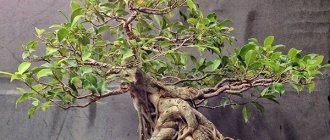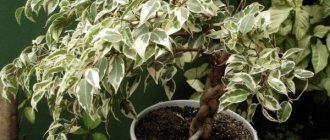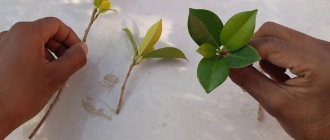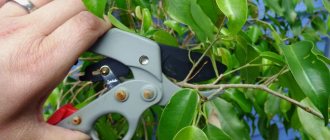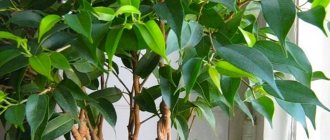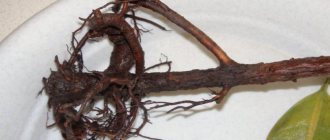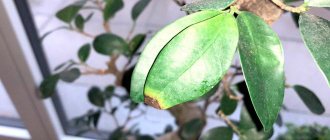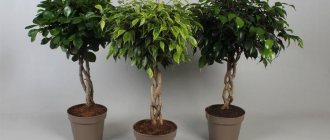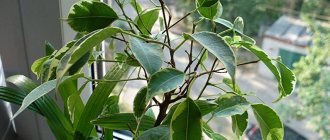Ficus benjamina is a houseplant that is most often used to decorate the interior and give it a spectacular look. Even a single plant with its thick, bright green crown refreshes the air in the room and caresses the eyes of those around with its beauty. And if your ficus also has an unusual crown or a trunk intertwined in the form of an ornament, then all your neighbors and friends will envy you. How to get such a copy? In this article we will tell you how to form a lush crown of a plant, braid its trunk with a braid or trellis, and also grow Ficus Benjamin in the form of a bonsai. There will be a lot of video footage here, because some actions are quite difficult to describe in words alone.
Pruning ficus benjamina at home
Almost all varieties of ficus benjamina require pruning. This is necessary for their rejuvenation and for the formation of a beautiful appearance. This plant has very thin and weak vertical shoots. Under the weight of the leaves, they quickly take a horizontal position and stick out in different directions. The crown of the bush becomes untidy. With the help of trimming and pinching it is brought into order.
Ficus benjamina is easier to shape than many other indoor plants. Moreover, all parts of this amazing plant can be given a special look, for example:
- the crown can be left as is, spreading, or can be formed in the form of a ball or dome;
- the roots can be located in the soil, or on the surface - in the form of a bizarre sculpture;
- the trunks can be smooth and straight, or you can give them a curved shape, you can braid them or twist them into a spiral;
- If you wish, you can grow a tall tree up to the ceiling, or you can create a dwarf tree in the bonsai style with your own hands.
True, you must clearly understand what type of specimen you want to get, and select suitable ficus varieties in accordance with this. Because, for example, you will not be able to grow a tree to the ceiling from the dwarf ficus variety Benjamin under any conditions.
How to prune ficus benjamina so that it grows beautifully
You can cut off an extra branch at any time of the year, but major pruning should be done in the spring, when Benjamin ficuses grow especially quickly. Do not prune in autumn-winter - the life processes of the plant slow down, it is preparing for a dormant period.
To trim shoots, only sharp and sterile tools (scissors, knives, pruners) should be used to avoid damaging the bark and causing infection. Make each cut at an angle to the upper edge above the dormant bud, and immediately treat it with potassium permanganate or sprinkle with crushed activated carbon. Next, we will tell you how to give your ficus an original appearance.
Ball-shaped crown
It is enough to pinch the young specimen from above. In an adult bush, the central shoot should be trimmed at a height of 30–35 cm. Young lateral shoots should be trimmed gradually, from February to July, giving the crown the desired shape. Remove newly appeared shoots at the bottom of the trunk.
Anti-aging pruning
This type of pruning is carried out on large Benjamin ficuses, which need to be restored to their former decorative appearance. Sometimes, if there is no watering for a long time, all the branches of the plant dry out. It may seem that the ficus is dead, but it is not. The bush requires anti-aging pruning. It should be carried out before the beginning of the growing season, or rather at the beginning of spring. Dry branches must be completely cut out, and living branches must be shortened by about half. Please note that you need to trim not only the main shoots, but also the secondary branches. The sections are carefully processed.
If the ficus has completely dried out, it can be cut back to a stump. In this case, even the trunk of the Benjamin ficus is almost completely removed. The remaining stump should be no more than 10 cm in height. After such severe pruning, the plant gradually restores its crown, growing new young branches.
Weaving the trunk of ficus benjamina
Spiral
This is the most common type of ficus Benjamin weaving. The reason for the popularity of this method lies in its simplicity and small number of sprouts. Two sprouts are enough, but with three the weaving will look more decorative. Young ficuses should be the same length, about 15 cm. Their trunks should be no more than half lignified. In most cases, a strong support is enough for the flower trunks, around which the stems weave clockwise. The most important thing is to remove side shoots and guide the plant in time. When the spiral of stems reaches the desired height, the support can be removed from the pot, and the flower will delight with its intertwined trunk. In some cases, a spiral can be made from 4 shoots, but with such a trunk there will be more trouble.
This may be interesting: How to overcome the difficulties of caring for Poliscias
Pigtail
To give the trunk this unusual shape, three or four ficus seedlings of the same length, about 13 cm, and thickness from one to one and a half cm should be planted in one pot at once. This length will already be enough to start braiding. If the thickness of the stems is less than one cm, wait a while with weaving.
First, remove all side branches from the stems, leaving only the tops. Now water the soil in the pot well to make the stems more flexible. If you watered the plant in the evening, you can start weaving in the morning, i.e. The plant should remain watered for at least 10 hours. Then the trunks of young, well-watered ficus trees will easily lend themselves to weaving. But this is not like braiding your granddaughter’s hair before school. You will have to weave this braid for a long time, more than one month, in parts. The first time you will be able to make several turns. But the stems grow slowly, and you will make each next turn as they grow, cutting off the side shoots that appear from them.
The braided part of the trunks must be tied with a soft woolen thread so that they do not unravel. You can adjust the weaving force yourself. If you weave a little looser, gaps will appear between the stems. Insert into them, for example, sticks of the same thickness. Then you will remove these shelves. We assure you that adult ficus specimens will look very decorative. But this will not happen soon. In the meantime, the thread will need to be rewound every month so that it does not grow into the bark. If the weaving was tight, then during rewinding you may see droplets of white milky juice, which indicates damage to the bark. It's okay, the wounds will heal. And yet, make the next harness a little weaker.
The trunks must be tied with threads strictly at an angle of 45 degrees. If your ficus braid is tall enough, we recommend installing a support. Although, usually in this form, with an intertwined stem, the flower holds well in an upright position and does not need support.
Watch the video on how to braid ficus benjamina:
Column (splicing of trunks)
If you want all the stems of your trunks (from 3 to 5 pieces) to grow together into one, you need to carefully remove the bark from the seedlings in small parts at the joints. The trunks should have no side branches, only green tops. Secure the joints with soft thread or wire. Approximately, the trunks will grow together after five to six months. To prevent the thread or wire from growing into the bark, change it every month. The tree will turn out to be very original, with one but unusual trunk.
Lattice
You will need eight seedlings (classic lattice), but sometimes fewer are used if it is not possible to purchase a sufficiently voluminous planting container. The main thing is that their number must be even. Plant your seedlings in one line at the same distance from each other (this is a prerequisite). The sprouts should be the same length and width, not yet lignified. After some time, the seedlings will begin to grow and develop. Wait until the ficus grows to a height of 10 -13 cm and begin to form a green lattice. Take a cardboard pipe and insert it into the middle, thereby crossing all adjacent trunks. Guide them to the desired position using polyethylene or coiled wire. Remember to periodically loosen the clamps to avoid damaging the bark and branches.
The lattice may not be perfectly straight; it may have a curve that will give your design individuality and its own charm.
To better understand the process of weaving ficus benjamina in the form of a lattice, we recommend watching the videos below:
Circular weaving
Circular weaving is done in the same way as lattice weaving, only the sprouts are planted not in one line but in a circle or square. The video clearly shows how to properly plant and intertwine cuttings.
Sometimes circular weaving is created in a different way, using a coconut stem, which is installed in the center of the flowerpot. In this case, seedlings are planted around this trunk at a short distance from it. The side shoots of the sprouts are removed. Considering the fact that the coconut trunk has high humidity, the aerial roots of the ficus will begin to actively develop and intertwine with each other, creating an unusual composition that looks like a vase. If there is no coconut trunk, use a homemade tube made of thick cardboard. To direct the stems and branches in the direction you want, feel free to use a soft thread or insulated thin wire, just do not over-tighten the shoots so as not to damage the ficus. Then both the wire and thread must be carefully removed from the plant.
This may be interesting: Fittonia: care at home
Pigtail
Some people believe that it doesn’t take a lot of work to braid a hair. You just need to get a few ficus trees somewhere and start braiding them. In words, in fact, everything is elementary, in reality it is much more complicated, but not impossible.
In order to get what you want, you should adhere to the following rules:
- It is necessary to select several young cuttings (at least 3) and plant them in one flowerpot not far from each other. This is important because it will make it possible not only to weave the trunks neatly, but also aesthetically.
- When lateral shoots appear on the stems, they will need to be trimmed so that only the tops remain.
- Before you start weaving, the flower is well watered. This will allow the stems to be more flexible and better amenable to the procedure.
Important! There must be 10-12 hours between the two events, otherwise the desired effect will not be achieved.
If the thickness of the trunk is less than 1 cm, then it is better to postpone the weaving procedure until the indicators are within 1 -1.5 cm.
It is a mistake to think that you can not only learn how to weave a ficus at once, but also do it quickly. Such manipulation will be extended for at least months. This is due to the slow growth of the trunk. At first, you can make several turns. Do not forget to tie the braided branches, because they will quickly disperse.
As for the method of weaving, or it would be more correct to say the force with which this will all happen, it all depends solely on personal preferences. If you want to leave a gap between the stems, this can be done - such weaving will look very original. If you want to bring your work as close as possible to the work of creating a braid, please do so. This option looks strict and elegant at the same time.
Some gardeners come up with their own variations, weaving, for example, the third stem in a special way, making it stand out from the crowd. It depends on everyone’s imagination and wishes.
In the case when you want to achieve the effect of “one common trunk,” the bark should be cut off in the places of future interweaving. Experienced gardeners say that the effect will not be long in coming and within six months you will have the feeling that this is one ficus “sitting” in a pot, a ficus with such an unusual trunk.
Types of Bonsai
If you want to grow a bonsai with your own hands, we’ll tell you about that too. Bonsai are miniature trees that resemble their larger relatives in their appearance (crown and roots). Translated from Chinese, the word “bonsai” means “grown in a tray.” For blanks, we use ficus Benjamin suitable for this variety, such as “Natasha”, “Exotica”, “Viandi” and others, which have all the necessary characteristics for creating a miniature tree with your own hands, namely:
- The presence of a branched root system.
- The original trunks are ornate, curved or grooved.
- Beautiful looking bark. For some it is smooth and light, for others it is textured and colorful.
- The leaves are small in size, since they are more suitable than large ones for creating the “dwarfism” effect.
- Relatively fast growth. If creating a bonsai from an ordinary ficus will take five to seven years, then varieties with rapid shoot growth will allow you to grow an excellent bonsai in two to three years.
It is equally important to determine what the shape of the future bonsai should be. You must have a good idea of what you will strive for.
Let us introduce you to the most common bonsai forms suitable for Ficus Benjamin.
Tekkan (classical or upright)
We recommend starting your first bonsai with it. The distinctive features of this form are a straight, thick trunk, free from branches from below, a widely branched root system, the number of branches decreases towards the upper part of the crown. We can say that this is a miniature copy of the classic pyramidal tree.
Moyogi (erect irregular)
The stem of this shape is slightly curved in one or more places. The general position of the tree remains vertical. The crown of the tree is compact and does not extend beyond the pot.
Shakan (oblique)
The stem of such a ficus is tilted to one side, as if turning the roots outward on the other side.
Sokan (forked)
In this type of bonsai, two trees grow from one root: the larger one is conventionally considered the “parent”, and the other, smaller one is its “child”. It looks beautiful if the parent tree is tall and thick, and the child is short and much thinner.
Hokidachi (broom-shaped)
This form of bonsai is not at all easy to create, although you can’t tell from the outside. Ideally, branches and roots should diverge equally from the trunk in different directions.
Yose-ue (grove)
This form of bonsai involves the presence in one container of several Benjamin ficuses, differing in age and thickness of the stems. It is desirable that the composition consist of at least five copies.
Spiral and hedge
The circular weaving of Ficus Benjamin is also called spiral weaving. This technique is no less attractive than others, so people pay attention to it. Another advantage is that weaving in the round is much easier than creating a lattice or braid.
If you want to know how to braid a Benjamin ficus, then you need to do everything in the following sequence:
- A strong support should be installed near the cutting or cuttings.
- As the trunk grows, it will need to be wound in a circle around a support. In this case, the side shoots are superfluous, so do not forget to trim them in time.
- When the bush stops growing, the support can be removed. This manipulation should not be rushed, because there have been cases when the barrel was pushed back in such a way that something unusual happened. In this case, the entire decorative appearance may be lost.
When the trunks are intertwined, the task can be considered completed. Next, the gardener only has to care for the flower and admire its beauty.
DIY ficus benjamina bonsai
Once you have chosen the right type of bonsai for your pet, start growing it. First of all, you need to choose a suitable container - wide and shallow, always with drainage holes in the bottom. At the bottom you should put a good layer of drainage, a layer of clean river (coarse) sand, and then a layer of nutritious soil suitable for ficuses. Ready-made soil is suitable for Mulberry or Palm.
For a prepared young plant, trim the root system and central shoot at a height of 15 cm. Plant to the level of the root collar, lightly compacting the soil. Water it. Keep the flower in light partial shade for a couple of weeks. Provide good care (Read about caring for your ficus benjamina here ). Maintain the temperature at 25–27 degrees. When the plant takes root and the roots become stronger, begin to gradually prune the branches.
The roots are given the desired shape by repeatedly pruning the main trunk. Regularly pinch out the top bud of the plant. Then the tree will grow wider and not higher. At the same time, the roots will grow.
When the root system and the upper part of the tree grows, transplant the ficus into a larger pot (wide and not deep). Repeat pruning the roots and top branches as you did the first time. With each subsequent transplant, lift the roots a little higher so that they are on the surface of the soil. Ficuses in nature often grow on rocks and rocky soil, clinging to stones with massive roots. You can also place pebbles coated with a mixture of powdered clay and soil under the roots. This technique will allow the ficus roots to stick to the cobblestones, imitating their natural habitat. This creates the effect of roots coming out.
Let us draw your attention to the fact that it will be easier for ficus to stick to rough stones. And further. There is no need to cover the root part of ficuses with soil, moss or pebbles. Just for decoration, you can put colored pebbles or some unusual figures in the pot.
It is advisable to replant no more than once a year, since adaptation takes a lot of time, and frequent replanting can cause the foliage to drop.
This may be interesting: Calathea - subtleties of care
When the stem reaches the required thickness, stop replanting. Now just trim and shape the crown.
Crown formation
Fast-growing varieties of ficus are cut to two to four leaves after 6 to 8 new ones grow on the shoot. When pruning, milky sap (latex) will appear on the cuts. This is fine. Do not touch it or wipe it with anything. Use clean tools (small scissors, pruning shears or knife). Powder the cut areas with crushed coal or lubricate with garden pitch.
Start pruning from the bottom and gradually move up to the crown. Trim only the necessary shoots, do not touch the leaves, as damaged leaves quickly turn brown and take on an unkempt appearance. Plan major pruning in early spring before the plant begins to grow vigorously. In spring and summer, you can also prune branches, but not so much as to not provoke intensive growth of thin side branches. But in the fall, from October, and in winter, when the ficuses are in the dormant stage, pruning should be stopped altogether.
Shaping the trunk
A stem of the desired shape and length can be obtained in different ways. Let's look at them one by one.
Garter
This method is used when you need to get a curved stem or change the direction of a branch. Tie the top or desired branch to the base of the plant. It will take a lot of time until the ficus gets used to the slope you need and begins to independently maintain the given shape. Then the garter can be removed.
Wire construction
The wire used is special - thin, insulated. Immediately after transplanting and cutting off the branches, this method cannot be used; let the tree get stronger. Only after this can you wrap the stem with wire, starting from the bottom, from the roots, gradually moving up the trunk towards the crown. You cannot pull the trunk and branches too tightly with wire - there is a fear that by doing this you will disrupt the vital processes in the tissues of the tree, and it will begin to dry out. (Or unsightly scars form on the bark).
Having secured the wire in the right places, leave the structure for at least a couple of months so that the tree gets used to the given appearance and learns to maintain it independently. When the time comes to get rid of the wire structure, do not unwind or break it with your hands - you will definitely damage the necessary branches. Only by carefully cutting the wire in all the necessary places will you keep the resulting appearance of your bonsai safe and sound.
Some Special Requirements for Successful Bonsai Growth
- Ficus bonsai are grown in shallow wide flowerpots, in which the soil dries out much faster than in ordinary pots. Therefore, you should pay close attention to watering this little miracle. It will be better if you get into the habit of watering it daily in small portions.
- Daily spraying is also recommended.
- Good lighting is necessary. In winter - up to 12 hours a day, and in summer - up to 16 hours.
- It is almost impossible to grow a beautiful and healthy bonsai without additional feeding. Feed it regularly, starting in spring, with liquid organic and mineral fertilizers a couple of times a month. After transplanting for about a month, no feeding is needed. In winter, one feeding per season is enough.
The video shows the creation of Bonsai from ficus benjamina step by step:
Ficus crown formation
- The ficus produces new shoots from the buds, the activity of which depends on the location. The upper buds give rapid growth; this must be taken into account when forming the ficus crown.
- Not every ficus can be shaped the way you want, since each species has its own shape by nature. The Ficus Benjamin bushes on its own, but the Rubber Ficus shoots upward, shedding its lower leaves, and you will have to work hard to form its crown.
- It is very important at what period you prune the ficus. If you cut off the top shoot in winter, only one of the side shoots may have enough strength for new growth, and your ficus will grow one-sided. If you prune in the spring, the ficus has enough strength and time to grow evenly in all directions that you can stimulate.
- The formation of a ficus trunk is easier to do in young plants. An adult plant no longer has the necessary flexibility and can ruin your experiment before you ruin the ficus.
- You need to cut the shoot above the bud. If the shoot is thick, the cut should be oblique.
- If the apartment has high humidity, aerial roots may periodically appear on the ficus. Help them reach the goal, guide them into the soil.
Depending on the type of ficus, you can shape its crown in different ways: bush, trunk, arc, bonsai. More complex forms relate to sculptures and ficus weaving.
How to make a ficus standard
You will need a young ficus with a formed vertical central shoot. Trim side shoots regularly until only the top 5 branches remain. When your trunk grows to the desired height, pinch the top and constantly trim the side shoots. While the ficus is young and its trunk is not yet sufficiently woody, you need to support the plant by tying it to a support fixed in the soil.
- How to transplant and propagate poinsettia
Try growing a multi-tiered trunk. To do this, divide the ficus crown into several parts. For example, you have 5 of them, from the first, third and fifth parts you need to form tiered crowns, and the second and fourth parts will be the spaces between these tiers - here the shoots need to be trimmed.
